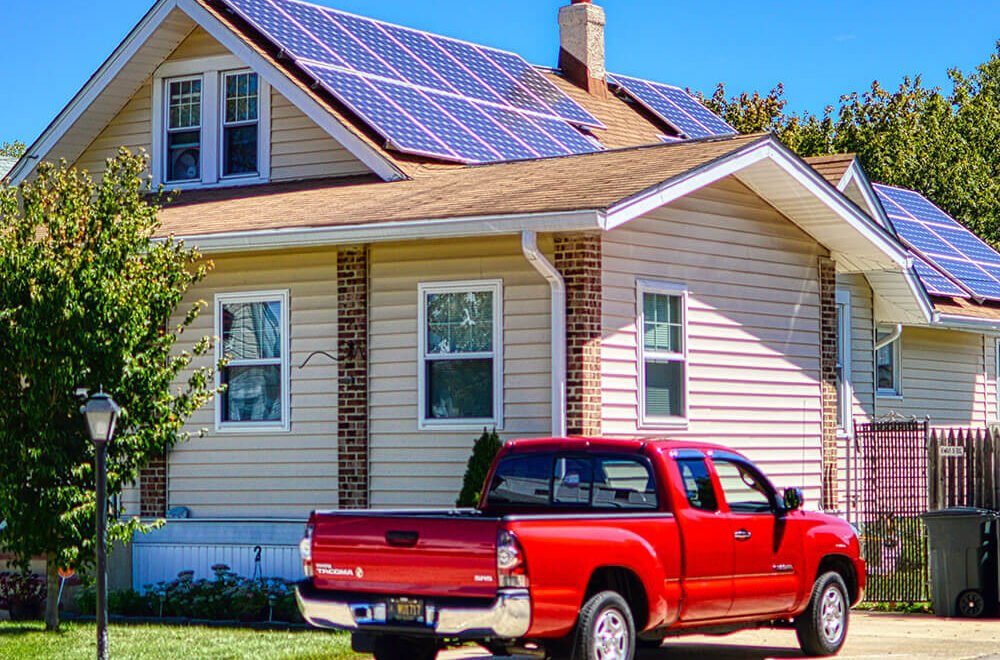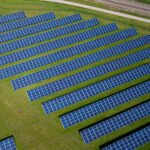Le système de production d'énergie solaire se compose d'un ensemble de cellules solaires, contrôleur solaire, et batterie (ensemble). Si la puissance de sortie est AC 220 V ou 110 V, il doit également être équipé d'un onduleur.
Le système de production d'énergie solaire est divisé en système de production d'énergie hors réseau et système de production d'énergie connecté au réseau.:
- Système de production d'électricité hors réseau. Il est principalement composé de modules solaires, manette, et batterie. Pour alimenter les charges CA, un onduleur AC est également requis.
- Le système de production d'électricité connecté au réseau est le courant continu généré par les modules solaires via l'onduleur connecté au réseau en courant alternatif qui répond aux exigences du réseau électrique après un accès direct au réseau public.. Les systèmes de production d'électricité connectés au réseau sont centralisés. Les centrales électriques connectées au réseau à grande échelle sont généralement des centrales électriques nationales., la caractéristique principale est l'énergie produite directement sur le réseau, et le déploiement unifié de l'alimentation électrique des utilisateurs. Cependant, ce type de centrale électrique nécessite un investissement important, une longue période de construction, et grande surface au sol, et il n'y a pas eu trop de développement. Le petit système de production d’électricité décentralisé connecté au réseau, en particulier le système de production d'énergie intégré au bâtiment photovoltaïque, est le courant dominant de la production d’électricité actuelle connectée au réseau en raison des avantages d’un petit investissement, construction rapide, faible encombrement, et un soutien politique fort.
Panneau solaire
Les panneaux solaires sont l'élément central d'un système d'énergie solaire. Le rôle des panneaux solaires est de convertir l’énergie lumineuse du soleil en énergie électrique, puis de produire de l’énergie CC pour la stocker dans une batterie.. Le panneau solaire est l'un des composants les plus importants d'un système d'énergie solaire, et son taux de conversion et sa durée de vie sont des facteurs importants pour déterminer si une cellule solaire est précieuse. Conception des modules: Conçu selon la norme CEI:1215:1993 standard, 36 ou 72 les cellules solaires en silicium polycristallin sont connectées en série pour former différents types de modules de 12 V et 24 V. Les modules peuvent être utilisés dans divers systèmes photovoltaïques domestiques, centrales photovoltaïques autonomes et centrales photovoltaïques connectées au réseau, etc..
Caractéristiques des matières premières du module solaire
Cellule: Haute efficacité (16.5% ou plus) Un ensemble de cellules solaires en silicium monocristallin est utilisé pour assurer une production d'énergie suffisante des panneaux solaires..
Verre: Verre chanfreiné trempé à faible teneur en fer (également connu sous le nom de verre blanc) avec une épaisseur de 3,2 mm est utilisé, avec une transmission de 91% ou plus dans la plage de longueurs d’onde de la réponse spectrale de la cellule solaire (320-1100nm) et une réflectance élevée pour la lumière infrarouge supérieure à 1200 nm. Ce verre est également résistant aux rayons ultraviolets solaires, et la transmission ne diminue pas.
EVA: Couche de film EVA de haute qualité de 0,78 mm d'épaisseur avec agent anti-UV, L'antioxydant et l'agent de durcissement sont utilisés comme agent d'étanchéité de la cellule solaire et agent de liaison entre le verre et le TPT.. Il a une transmission lumineuse élevée et une capacité anti-âge.
TPT: Le revêtement arrière de la cellule solaire – le film fluoroplastique est blanc, qui joue un rôle réfléchissant à la lumière du soleil, donc cela améliore légèrement l'efficacité du module, et en raison de sa haute émissivité infrarouge, cela peut également réduire la température de fonctionnement du module, ce qui contribue également à améliorer l’efficacité du module. Bien sûr, ce film plastique fluoré répond aux exigences de base en matière de résistance au vieillissement, résistance à la corrosion et imperméabilité requises par les matériaux d'encapsulation des cellules solaires.
Cadre: Le cadre en alliage d'aluminium utilisé présente une résistance élevée et une forte résistance aux chocs mécaniques. C'est également la partie la plus précieuse du système d'énergie solaire..
Contrôleur solaire
Le contrôleur solaire est composé d'un processeur spécial CPU, composants électroniques, afficher, commutation de tubes de puissance, etc..
Principales caractéristiques:
- L'utilisation d'un ordinateur monopuce et d'un logiciel spécial, pour obtenir un contrôle intelligent;
- Contrôle précis de la décharge grâce à la correction des caractéristiques du taux de décharge de la batterie. La tension de fin de décharge est le point de contrôle corrigé par la courbe du taux de décharge, éliminant l'imprécision d'un simple contrôle de tension lors de la décharge, conforme aux caractéristiques inhérentes de la batterie, c'est, différents taux de décharge ont des tensions finales différentes.
- Avec surcharge, décharge excessive, court-circuit électronique, protection de surcharge, protection de connexion anti-retour unique et autre contrôle entièrement automatique; aucune des protections ci-dessus n'endommage aucune pièce et ne brûle pas l'assurance;
- L'utilisation du circuit principal de charge série PWM, de sorte que la perte de tension du circuit de charge par rapport à l'utilisation d'un circuit de charge à diode est réduite de près de moitié, l'efficacité de la charge est 3%-6% supérieur au non-PWM, augmenter le temps de consommation d'énergie; récupération par décharge excessive de la charge boost, charge directe normale, mode de contrôle automatique de charge flottante pour prolonger la durée de vie du système; en même temps avec une compensation de température de haute précision;
- Le tube électroluminescent LED intuitif indique l'état actuel de la batterie, afin que les utilisateurs comprennent l'utilisation du statut;
6, tous contrôlent tous utilisent des puces de qualité industrielle (uniquement pour le contrôleur de qualité industrielle I), peut fonctionner librement par temps froid, haute température, environnement humide. Également utilisé le contrôle de synchronisation du cristal, contrôle du timing précis. - Suppression du potentiomètre pour ajuster le point de consigne de contrôle, et l'utilisation de la mémoire E-square pour enregistrer le travail des points de contrôle, pour que les réglages soient numériques, éliminant le décalage de vibration du potentiomètre, dérive de température et autres facteurs qui font que l'erreur du point de contrôle réduit la précision et la fiabilité;
- L'utilisation de l'affichage LED numérique et des paramètres, une opération clé peut être complétée tous les paramètres, l'utilisation d'un rôle extrêmement pratique et intuitif consiste à contrôler l'état de fonctionnement de l'ensemble du système, et la batterie pour jouer le rôle de protection contre les surcharges, protection contre les décharges excessives. Dans des endroits avec de grandes différences de température, le contrôleur qualifié doit également avoir la fonction de compensation de température. Autres fonctions supplémentaires telles que des interrupteurs commandés par la lumière, les interrupteurs temporisés devraient être facultatifs pour le contrôleur;




